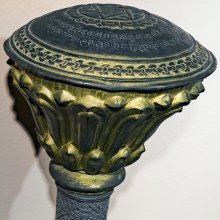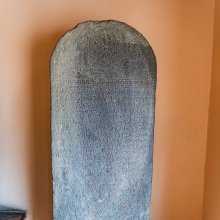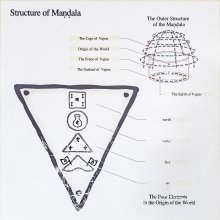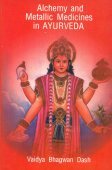Prithvi, Pṛthvī: 35 definitions
Introduction:
Prithvi means something in Buddhism, Pali, Hinduism, Sanskrit, Jainism, Prakrit, the history of ancient India, Hindi, biology. If you want to know the exact meaning, history, etymology or English translation of this term then check out the descriptions on this page. Add your comment or reference to a book if you want to contribute to this summary article.
The Sanskrit term Pṛthvī can be transliterated into English as Prthvi or Prithvi, using the IAST transliteration scheme (?).
Alternative spellings of this word include Prathvi.
Images (photo gallery)
In Hinduism
Ayurveda (science of life)
Rasashastra (Alchemy and Herbo-Mineral preparations)
Source: Wisdom Library: Rasa-śāstraPṛthvī (पृथ्वी):—One of the sixty-seven Mahauṣadhi, as per Rasaśāstra texts (rasa literature). These drugs are useful for processing mercury (rasa), such as the alchemical processes known as sūta-bandhana and māraṇa.
Nighantu (Synonyms and Characteristics of Drugs and technical terms)
Source: Wisdom Library: Raj NighantuPṛthvī (पृथ्वी) refers to “earth” and is mentioned in a list of 53 synonyms for dharaṇi (“earth”), according to the second chapter (dharaṇyādi-varga) of the 13th-century Raj Nighantu or Rājanighaṇṭu (an Ayurvedic encyclopedia). The Dharaṇyādi-varga covers the lands, soil [viz., Pṛthvī], mountains, jungles and vegetation’s relations between trees and plants and substances, with their various kinds.
Source: WorldCat: Rāj nighaṇṭuPṛthvī (पृथ्वी) is another name for Punarnavā, a medicinal plant identified with Trianthema portulacastrum Linn. or “desert horsepurslane” from the Aizoaceae or “fig-marigold” family of flowering plants, according to verse 5.115-116 of the 13th-century Raj Nighantu or Rājanighaṇṭu. The fifth chapter (parpaṭādi-varga) of this book enumerates sixty varieties of smaller plants (kṣudra-kṣupa). Together with the names Pṛthvī and Punarnavā, there are a total of eight Sanskrit synonyms identified for this plant.
Unclassified Ayurveda definitions
Source: gurumukhi.ru: Ayurveda glossary of termsPṛthvī (पृथ्वी):—1. One of the five basic elements (Paṅcamahābhūtas) that make up all matter in the universe. 2. Earth. Indicative of solidity, mass, stability, compactness.

Āyurveda (आयुर्वेद, ayurveda) is a branch of Indian science dealing with medicine, herbalism, taxology, anatomy, surgery, alchemy and related topics. Traditional practice of Āyurveda in ancient India dates back to at least the first millenium BC. Literature is commonly written in Sanskrit using various poetic metres.
Yoga (school of philosophy)
Source: Wisdom Library: YogaPṛthvī (पृथ्वी, “earth”):—One of the five gross elements assigned as a zone (or sphere) to the human body (bhūtamaṇḍala), according the Yogatattva-upaniṣad. The element earth is assigned to the region from the feet up to the knees. Earth is represented by a square (caturasra), the colour yellow (pīta) and the syllable la (ल). The deity presiding over this region is Brahmā;
Source: ORA: Amanaska (king of all yogas): A Critical Edition and Annotated Translation by Jason BirchPṛthvī (पृथ्वी) refers to the “earth element”, according to the twelfth-century Vivekamārtaṇḍa 158.—Accordingly, “Having become absorbed in the earth element (pṛthvī), which is bright like orpiment and gold, yellow, endowed with the syllable la, presided over by Brahmā, square [in shape] and located in the heart, [the Yogin] should hold his breath and mind in it for two hours. This dhāraṇā on the earth [element] makes [the Yogin] constantly steady and a master of the earth [element]”.

Yoga is originally considered a branch of Hindu philosophy (astika), but both ancient and modern Yoga combine the physical, mental and spiritual. Yoga teaches various physical techniques also known as āsanas (postures), used for various purposes (eg., meditation, contemplation, relaxation).
Purana and Itihasa (epic history)
Source: archive.org: Shiva Purana - English TranslationPṛthvī (पृथ्वी) refers to the “(whole) earth”, according to the Śivapurāṇa 2.2.35. Accordingly, as Viṣṇu said to Dakṣa:—“[...] on hearing these words of Viṣṇu, Dakṣa began to ponder. He sat quietly on the ground with his face turned pale. [...] The whole earth (pṛthvī) containing the seven continents shook with fear. All the oceans, forests and mountains were excessively agitated”.
Source: Cologne Digital Sanskrit Dictionaries: The Purana Index1a) Pṛthvī (पृथ्वी).—First milked by Brahmā; Calf Vāyu; In Svāyambhuvamanvantara by Agnidhara—Calf Svāyambhuva. In Svārociṣa by Caitra—Calf Svārociṣa Manu. In Uttama by Devabhuja—Calf Uttama Manu. In Tāmasa by Bālabandhu—Calf Tāmasa Manu. In Cāriṣṇava by Purāṇa—Calf Cariṣṇava Manu. In Cākṣuṣa by Purāṇa— Calf Cākṣuṣa Manu. In Vaivasvata by Vainya—Calf Soma.*
- * Vāyu-purāṇa 63. 12-19.
1b) The first seven vātaskandas; also known as āhava.*
- * Vāyu-purāṇa 67. 114.

The Purana (पुराण, purāṇas) refers to Sanskrit literature preserving ancient India’s vast cultural history, including historical legends, religious ceremonies, various arts and sciences. The eighteen mahapuranas total over 400,000 shlokas (metrical couplets) and date to at least several centuries BCE.
Shilpashastra (iconography)
Source: Wisdom Library: Śilpa-śāstraPṛthvī (पृथ्वी) is a synonym for adhiṣṭhāna (‘platform’), according to the Kāśyapaśilpa 6.1-2. The word adhiṣṭhāna is Sanskrit technical term referring to the “base” or “platform” on which a structure is built.

Shilpashastra (शिल्पशास्त्र, śilpaśāstra) represents the ancient Indian science (shastra) of creative arts (shilpa) such as sculpture, iconography and painting. Closely related to Vastushastra (architecture), they often share the same literature.
Vaisheshika (school of philosophy)
Source: Wikipedia: VaisheshikaPṛthvī (पृथ्वी, “earth”) is one of the nine dravyas (‘substances’), according to the Vaiśeṣika-sūtras. These dravyas are considered as a category of padārtha (“metaphysical correlate”). These padārthas represent everything that exists which can be cognized and named. Together with their subdivisions, they attempt to explain the nature of the universe and the existence of living beings. Pṛthvī is also regarded as one of the five bhūtas (‘elements’) possessing a specific quality making it cognizable.

Vaisheshika (वैशेषिक, vaiśeṣika) refers to a school of orthodox Hindu philosophy (astika), drawing its subject-matter from the Upanishads. Vaisheshika deals with subjects such as logic, epistemology, philosophy and expounds concepts similar to Buddhism in nature
Natyashastra (theatrics and dramaturgy)
Source: Wisdom Library: Nāṭya-śāstraPṛthvī (पृथ्वी) is another name for Vilambitagati, which refers to a type of syllabic metre (vṛtta), according to the Nāṭyaśāstra chapter 16. In this metre, the second, the sixth, the eighth, the twelfth, the fourteenth, the fifteenth and the seventeenth syllables of a foot (pāda) are heavy (guru), while the rest of the syllables are light (laghu).
⏑⎼⏑¦⏑⏑⎼¦⏑⎼⏑¦⏑⏑⎼¦⏑⎼⎼¦⏑⎼¦¦⏑⎼⏑¦⏑⏑⎼¦⏑⎼⏑¦⏑⏑⎼¦⏑⎼⎼¦⏑⎼¦¦
⏑⎼⏑¦⏑⏑⎼¦⏑⎼⏑¦⏑⏑⎼¦⏑⎼⎼¦⏑⎼¦¦⏑⎼⏑¦⏑⏑⎼¦⏑⎼⏑¦⏑⏑⎼¦⏑⎼⎼¦⏑⎼¦¦
Pṛthvī falls in the Atyaṣṭi class of chandas (rhythm-type), which implies that verses constructed with this metre have four pādas (‘foot’ or ‘quarter-verse’) containing seventeen syllables each.
Source: Shodhganga: Mankhaka a sanskrit literary genius (natya)Pṛthvī (पृथ्वी) is the name of a Sanskrit metre (chandas) of the Vṛtta-type (akṣarachandas: metres regulated by akṣaras, syllabes).—This metre, Pṛthvī with seventeen syllables in each quarter and the gaṇas therein are in the order of ja, sa, ja, sa and ya. This metre is found to be employed in the Śrīkaṇṭhacarita.

Natyashastra (नाट्यशास्त्र, nāṭyaśāstra) refers to both the ancient Indian tradition (shastra) of performing arts, (natya—theatrics, drama, dance, music), as well as the name of a Sanskrit work dealing with these subjects. It also teaches the rules for composing Dramatic plays (nataka), construction and performance of Theater, and Poetic works (kavya).
Chandas (prosody, study of Sanskrit metres)
Source: Shodhganga: a concise history of Sanskrit Chanda literature1) Pṛthvī (पृथ्वी) refers to one of the 27 metres mentioned in the Suvṛttatilaka ascribed to Kṣemendra (11th century). The Suvṛttatilaka is a monumental work of Sanskrit prosody considered as unique in its nature. In this work Kṣemendra neither introduces any new metre nor discusses all the metres used in his time. He discusses 27 popular metres (e.g., Pṛthvī) which were used frequently by the poets.
2) Pṛthvī (पृथ्वी) is the alternative name of a Sanskrit metre (chandas) mentioned by Hemacandra (1088-1173 C.E.) in his auto-commentary on the second chapter of the Chandonuśāsana. Pṛthvī corresponds to Vilambitagati (according to Bharata). Hemacandra gives these alternative names for the metres by other authorities (like Bharata), even though the number of gaṇas or letters do not differ.
3) Pṛthvī (पृथ्वी) refers to one of the 135 metres (chandas) mentioned by Nañjuṇḍa (1794-1868 C.E.) in his Vṛttaratnāvalī. Nañjuṇḍa was a poet of both Kannada and Sanskrit literature flourished in the court of the famous Kṛṣṇarāja Woḍeyar of Mysore. He introduces the names of these metres (e.g., Pṛthvī) in 20 verses.
4) Pṛthvī (पृथ्वी) refers to one of the 130 varṇavṛttas (syllabo-quantitative verse) dealt with in the second chapter of the Vṛttamuktāvalī, ascribed to Durgādatta (19th century), author of eight Sanskrit work and patronised by Hindupati: an ancient king of the Bundela tribe (presently Bundelkhand of Uttar Pradesh). A Varṇavṛtta (e.g., pṛthvī) refers to a type of classical Sanskrit metre depending on syllable count where the light-heavy patterns are fixed.
5) Pṛthvī (पृथ्वी) refers to one of the 34 varṇavṛttas (syllabo-quantitative verse) dealt with in the Vṛttamaṇimañjūṣā, whose authorship could be traced (also see the “New Catalogus Catalogorum” XXXI. p. 7).
6) Pṛthvī (पृथ्वी) refers to one of the seventy-two sama-varṇavṛtta (regular syllabo-quantitative verse) mentioned in the 334th chapter of the Agnipurāṇa. The Agnipurāṇa deals with various subjects viz. literature, poetics, grammar, architecture in its 383 chapters and deals with the entire science of prosody (e.g., the pṛthvī metre) in 8 chapters (328-335) in 101 verses in total.

Chandas (छन्दस्) refers to Sanskrit prosody and represents one of the six Vedangas (auxiliary disciplines belonging to the study of the Vedas). The science of prosody (chandas-shastra) focusses on the study of the poetic meters such as the commonly known twenty-six metres mentioned by Pingalas.
Vaishnavism (Vaishava dharma)
Source: Pure Bhakti: Brhad BhagavatamrtamPṛthvī (पृथ्वी) refers to:—Earth; goddess earth. (cf. Glossary page from Śrī Bṛhad-bhāgavatāmṛta).

Vaishnava (वैष्णव, vaiṣṇava) or vaishnavism (vaiṣṇavism) represents a tradition of Hinduism worshipping Vishnu as the supreme Lord. Similar to the Shaktism and Shaivism traditions, Vaishnavism also developed as an individual movement, famous for its exposition of the dashavatara (‘ten avatars of Vishnu’).
Ganitashastra (Mathematics and Algebra)
Source: archive.org: Hindu MathematicsPṛthvī (पृथ्वी) represents the number 1 (one) in the “word-numeral system” (bhūtasaṃkhyā), which was used in Sanskrit texts dealing with astronomy, mathematics, metrics, as well as in the dates of inscriptions and manuscripts in ancient Indian literature.—A system of expressing numbers by means of words arranged as in the place-value notation was developed and perfected in India in the early centuries of the Christian era. In this system the numerals [e.g., 1—pṛthvī] are expressed by names of things, beings or concepts, which, naturally or in accordance with the teaching of the Śāstras, connote numbers.

Ganitashastra (शिल्पशास्त्र, gaṇitaśāstra) refers to the ancient Indian science of mathematics, algebra, number theory, arithmetic, etc. Closely allied with astronomy, both were commonly taught and studied in universities, even since the 1st millennium BCE. Ganita-shastra also includes ritualistic math-books such as the Shulba-sutras.
General definition (in Hinduism)
Source: WikiPedia: HinduismPrithvi is the Sanskrit name for earth and its essence Prithivi Tattwa, in the name of a Hindu Deity. Prithvi is also called Dhra, Dharti, Dhrithri, meaning that which holds everything. Amongst lokas (worlds), it is also known as Bhu-loka.
etymology: Prithvi (Sanskrit: पृथ्वी pṛthvī, also पृथिवी pṛthivī).
In Buddhism
Tibetan Buddhism (Vajrayana or tantric Buddhism)
Source: OSU Press: Cakrasamvara SamadhiPṛthvī (पृथ्वी, “earth”) or Pṛthvīdhātu refers to “(the element of) earth” and is associated with Pātanī, according to the Cakrasaṃvara Samādhi [i.e., Cakrasamvara Meditation] ritual often performed in combination with the Cakrasaṃvara Samādhi, which refers to the primary pūjā and sādhanā practice of Newah Mahāyāna-Vajrayāna Buddhists in Nepal.—Accordingly, “[...] Mohavajrī in the eyes. Dveṣavajrī in the ears. Īrṣyāvajrī in the nostrils. Rāgavajrī in the mouth. Sūryavajrī in touch. Aiśvaryavajrī in the seat of all senses. The element of earth (pṛthvī-dhātu), Pātanī. The element of water, Māraṇī. The element of fire, Ākarṣaṇī. The element of wind, Padmanṛtyeśvarī. The element of Space, Padmajvālanī. Thus, the purity of the divinities in the seat of the elements”.

Tibetan Buddhism includes schools such as Nyingma, Kadampa, Kagyu and Gelug. Their primary canon of literature is divided in two broad categories: The Kangyur, which consists of Buddha’s words, and the Tengyur, which includes commentaries from various sources. Esotericism and tantra techniques (vajrayāna) are collected indepently.
General definition (in Buddhism)
Source: Wisdom Library: Dharma-samgrahaPṛthvī (पृथ्वी) refers to the thirteenth of the “fourteen world protectors” (caturdaśalokapāla) as defined in the Dharma-saṃgraha (section 10). The Dharma-samgraha (Dharmasangraha) is an extensive glossary of Buddhist technical terms in Sanskrit (e.g., caturdaśalokapāla and Pṛthvī). The work is attributed to Nagarguna who lived around the 2nd century A.D.
Pṛthvī (”solid“) refers to one of the “eleven tangibles” (spraṣṭavya) as defined in the Dharma-saṃgraha (section 38).
Pṛthvī (“earth”) also refers to one of the “five great elements” (mahābhūta) as well as one of the “six elements” (ṣaḍdhātu), defined in the Dharma-saṃgraha (section 39 and 58 respectively).
In Jainism
General definition (in Jainism)
Source: Wisdom Library: Jainism1) Pṛthvī (पृथ्वी) is the mother of Supārśva, the seventh of twenty-four Tīrthaṅkaras in Janism according to the Ācāradinakara (14th century work on Jain conduct written by Vardhamāna Sūri). A Tīrthaṅkara is an enlightened being who has conquered saṃsāra (cycle of birth and death), leaving behind him a path for others to follow.
The husband of Pṛthvī is Pratiṣṭha according to Śvetāmbara but Supratiṣṭha according to Digambara. It is an ancient Jain practice to worship the Tīrthaṅkara’s parents in various rites, such as the pratiṣṭhāvidhi.
2) Pṛthvī (पृथ्वी) is the mother of Svayambhū: the third Vāsudeva (“violent heroes”) according to both Śvetāmbara and Digambara sources. Since they enjoy half the power of a Cakravartin (universal monarch) they are also known as Ardhacakrins. Jain legends describe nine such Vāsudevas usually appearing together with their “gentler” twins known as the Baladevas. The legends of these twin-heroes usually involve their antagonistic counterpart known as the Prativāsudevas (anti-heroes).
The stories of queen Pṛthvī, king Soma and their son, Svayambhū are related in texts such as the Triṣaṣṭiśalākāpuruṣacarita (“the lives of the sixty-three illustrious persons”), a twelfth-century Śvetāmbara work by Hemacandra.
Source: archive.org: Trisastisalakapurusacaritra1) Pṛthvī (पृथ्वी) is the wife of Pratiṣṭha: an ancient king of Vārāṇasī and father of Supārśva, according to chapter 3.5 [supārśva-caritra] of Hemacandra’s 11th century Triṣaṣṭiśalākāpuruṣacaritra: an ancient Sanskrit epic poem narrating the history and legends of sixty-three illustrious persons in Jainism.—Accordingly, “Now in this Bhāratakṣetra of Jambūdvīpa there is a city Vārāṇasī, the ornament of the Kāśi-country. [...] Its king was named Pratiṣṭha, devoted to justice, the kalpa-tree of celebrity for the worthy, possessing celebrity like Indra. [...] The king (Pratiṣṭha) had a wife, named Pṛthvī, like a living earth, the receptacle of virtues, firmness, etc. Her innate virtue and beauty constantly became ornaments, and external ornaments reached a state of being adorned. In her, spotless by nature, numerous virtues appeared like pearls in the river Tāmraparṇī. [...]”.
2) Pṛthvī (पृथ्वी) is the wife of king Śaṅkha from Svarṇadruma, according to chapter 5.4 [śāntinātha-caritra].
3) Pṛthvī (पृथ्वी) is the wife of king Anaraṇya from Sāketa, according to the Jain Ramayana and chapter 7.4 [Rāma and Lakṣmaṇa].
4) Pṛthvī (पृथ्वी) is the wife of king Nandighoṣa, according to chapter 7.4.
5) Pṛthvī (पृथ्वी) is the wife of Vālikhilya from Kūbara, according to the Jain Ramayana and chapter 7.5 [The kidnapping of Sītā].
Source: HereNow4u: Lord Śrī MahāvīraPṛthvī (पृथ्वी) is the mother of Indrabhūti, Agnibhūti and Vāyubhūti: the first trough third of the eleven gaṇadharas (group-leader) of Mahāvīra.—Śramaṇa Lord Mahāvīra’s congregation had 11 gaṇadharas. All these were Brahmin householders from different places. All these gaṇadharas (for example, Indrabhūti, Agnibhūti and Vāyubhūti) were Brahmins by caste and Vedic scholars. After taking initiation, they all studied the 11 Aṅgas. Hence, all of them had the knowledge of the 14 pūrvas and possessed special attainments (labdhis).
Source: The University of Sydney: A study of the Twelve ReflectionsPṛthvī (पृथ्वी) refers to the “earth”, according to the 11th century Jñānārṇava, a treatise on Jain Yoga in roughly 2200 Sanskrit verses composed by Śubhacandra.—Accordingly, “This world totters to the limit of the world of Brahmā with the fear of the beginning of a frown, and mountains immediately fall asunder by force of [the fact that] the earth is overcome by the weight of the heavy feet, of those heroes who are all led to death by the king of time [com.—by force of [the fact that] the earth is pervaded by the weight of the excessively heavy feet (padagariṣṭhabharavyāptapṛthvīvaśena)] in [the space of] some days. Nevertheless, desire is intense only in a living being who is bereft of sense”.
Synonyms: Dhātrī, Bhū.

Jainism is an Indian religion of Dharma whose doctrine revolves around harmlessness (ahimsa) towards every living being. The two major branches (Digambara and Svetambara) of Jainism stimulate self-control (or, shramana, ‘self-reliance’) and spiritual development through a path of peace for the soul to progess to the ultimate goal.
India history and geography
Source: Project Gutenberg: Castes and Tribes of Southern India, Volume 1Prithvi (“earth”) is one of the many exogamous septs (division) among the Telugu section of the Devangas (a caste of weavers). The Devangas, speaking Telugu or Canarese, are found all over the Madras Presidency. Devanga is composed of Deva and angam, “limb of god”.
Source: Cologne Digital Sanskrit Dictionaries: Indian Epigraphical GlossaryPṛthvī.—(IE 7-1-2), ‘one’. Note: pṛthvī is defined in the “Indian epigraphical glossary” as it can be found on ancient inscriptions commonly written in Sanskrit, Prakrit or Dravidian languages.

The history of India traces the identification of countries, villages, towns and other regions of India, as well as mythology, zoology, royal dynasties, rulers, tribes, local festivities and traditions and regional languages. Ancient India enjoyed religious freedom and encourages the path of Dharma, a concept common to Buddhism, Hinduism, and Jainism.
Biology (plants and animals)
Source: Google Books: CRC World Dictionary (Regional names)1) Prithvi in India is the name of a plant defined with Amomum subulatum in various botanical sources. This page contains potential references in Ayurveda, modern medicine, and other folk traditions or local practices It has the synonym Cardamomum subulatum Kuntze (among others).
2) Prithvi is also identified with Trianthema portulacastrum It has the synonym Trianthema monogyna L., nom. illeg. (etc.).
Example references for further research on medicinal uses or toxicity (see latin names for full list):
· Flora Indica, or ‘Descriptions of Indian Plants’ (1820)
· Fl. Veracruz (1979)
· Monographs in Systematic Botany from the Missouri Botanical Garden (2001)
· Gardeners Dictionary, ed. 8 (1768)
· Kew Bulletin (1960)
· Revisio Generum Plantarum (1891)
If you are looking for specific details regarding Prithvi, for example diet and recipes, health benefits, pregnancy safety, chemical composition, side effects, extract dosage, have a look at these references.

This sections includes definitions from the five kingdoms of living things: Animals, Plants, Fungi, Protists and Monera. It will include both the official binomial nomenclature (scientific names usually in Latin) as well as regional spellings and variants.
Languages of India and abroad
Sanskrit dictionary
Source: DDSA: The practical Sanskrit-English dictionaryPṛthvī (पृथ्वी).—[pṛthu-ṅīṣ]
1) The earth; पृथ्वि त्वया धृता लोका देवि त्वं विष्णुना धृता (pṛthvi tvayā dhṛtā lokā devi tvaṃ viṣṇunā dhṛtā) Sandhyā.
2) The earth as one of the five elements.
3) Large cardamoms.
4) Name of a metre; (see App.I.)
Source: Cologne Digital Sanskrit Dictionaries: Edgerton Buddhist Hybrid Sanskrit DictionaryPṛthvī (पृथ्वी).—see Pṛthivī.
Source: Cologne Digital Sanskrit Dictionaries: Shabda-Sagara Sanskrit-English DictionaryPṛthvī (पृथ्वी).—f. (-thvī) 1. The earth. 2. A pungent seed. (Nigella Indica.) 3. A medical substance and condiment, perhaps the leaf of the asafœtida plant, “Hingupatri.” 4. The mother of the seventh Jina, or Jaina deified teacher, Suparswa. 5. Cardamoms. 6. Name of a metre. E. The feminine form of pṛthu, or pṛthu the king so named, and ṅīp aff.; the domain of king Prit'Hu.
Source: Cologne Digital Sanskrit Dictionaries: Monier-Williams Sanskrit-English Dictionary1) Pṛthvī (पृथ्वी):—[from pṛthu > pṛth] a f. See below.
2) [from pṛth] b f. (cf. pṛthivī) the earth (also as an element), [Ṛg-veda] etc. etc.
3) [v.s. ...] Nigella Indica, [cf. Lexicographers, esp. such as amarasiṃha, halāyudha, hemacandra, etc.]
4) [v.s. ...] Boerhavia Procumbens, [cf. Lexicographers, esp. such as amarasiṃha, halāyudha, hemacandra, etc.]
5) [v.s. ...] = hiṅgu-pattrī, [cf. Lexicographers, esp. such as amarasiṃha, halāyudha, hemacandra, etc.]
6) [v.s. ...] great cardamoms, [cf. Lexicographers, esp. such as amarasiṃha, halāyudha, hemacandra, etc.]
7) [v.s. ...] Name of 2 kinds of metre, [Colebrooke]
8) [v.s. ...] Name of the mother of the 7th Arhat of present Avasarpiṇī, [cf. Lexicographers, esp. such as amarasiṃha, halāyudha, hemacandra, etc.]
Source: Cologne Digital Sanskrit Dictionaries: Yates Sanskrit-English DictionaryPṛthvī (पृथ्वी):—(thvī) 3. f. The earth; a pungent seed; a drug; cardamoms; mother of the 7th Jaina.
Source: DDSA: Paia-sadda-mahannavo; a comprehensive Prakrit Hindi dictionary (S)Pṛthvī (पृथ्वी) in the Sanskrit language is related to the Prakrit word: Picchī.
[Sanskrit to German]
Sanskrit, also spelled संस्कृतम् (saṃskṛtam), is an ancient language of India commonly seen as the grandmother of the Indo-European language family (even English!). Closely allied with Prakrit and Pali, Sanskrit is more exhaustive in both grammar and terms and has the most extensive collection of literature in the world, greatly surpassing its sister-languages Greek and Latin.
Hindi dictionary
Source: DDSA: A practical Hindi-English dictionaryPṛthvī (पृथ्वी) [Also spelled prathvi]:—(nf) the earth, ground, terrestrial globe; ~[nātha/pati/pāla] a king; -[putra] the Mars; -[pūjā] geolatory; -[saṃbaṃdhī] terrestrial, earthly, tellurian.
...
Kannada-English dictionary
Source: Alar: Kannada-English corpusPṛthvi (ಪೃಥ್ವಿ):—
1) [noun] the planet which we are living on; the earth.
2) [noun] the soft, granular or crumbly part of land; soil; earth.
3) [noun] the Earth-Goddess, regarded as the Mother, as she nurtures all creatures.
4) [noun] the earth as one of the basic elements.
5) [noun] the plant Centrantherum anthelmenticum ( = Vernonia anthelmentica) of Asteraceae family; wild cumin.
6) [noun] its black seeds; black cumin; wild cumin.
7) [noun] a variety of cardamom plant Amomum subulatum of Zingiberaceae family.
8) [noun] its seed or seed capsule.
9) [noun] the plant Ferula assafoetida of Apiaceae family (from which asafoetida, the bad-smelling gum resin is obtained).
10) [noun] (pros.) a kind of verse having seventeen syllables in each line.
11) [noun] (jain.) one of the six elements.
Kannada is a Dravidian language (as opposed to the Indo-European language family) mainly spoken in the southwestern region of India.
See also (Relevant definitions)
Starts with (+43): Prithvi-linga, Prithvibhara, Prithvibhrit, Prithvibhuj, Prithvicandra, Prithvicandrarajarshi, Prithvicandrarajarshirasa, Prithvicandrodaya, Prithvidanavidhi, Prithvidandapala, Prithvidandapalata, Prithvidevi, Prithvidhara, Prithvidhara acarya, Prithvidhara bhatta, Prithvidharacarya, Prithvidhatu, Prithvidhava, Prithvigarbha, Prithvigola.
Ends with: Navakhandaprithvi.
Full-text (+190): Prithivi, Picchi, Prithu, Prithvidandapalata, Prithvibhara, Prithvigriha, Prithvitala, Prithvibhuj, Prithvikhata, Prithvipala, Prithvipati, Pancamahabhuta, Prithvisha, Prithvigarbha, Prithvija, Prithvidhara, Kritavidya, Tinatala, Prithvika, Samghata.
Relevant text
Search found 78 books and stories containing Prithvi, Pṛthvī, Prthvi, Pṛthvi; (plurals include: Prithvis, Pṛthvīs, Prthvis, Pṛthvis). You can also click to the full overview containing English textual excerpts. Below are direct links for the most relevant articles:
Garga Samhita (English) (by Danavir Goswami)
Verse 6.6.46 < [Chapter 6 - The Yādavas’ Victory When Śrī Rukmiṇī is Kidnapped]
Verse 2.1.51 < [Chapter 1 - Description of the Entrance in Vṛndāvana]
Verse 6.19.19 < [Chapter 19 - In the First Fortress of Dvārakā, the Glories of Līlā-sarovara, etc.]
Rig Veda (translation and commentary) (by H. H. Wilson)
Puranic encyclopaedia (by Vettam Mani)
The Concept of Sharira as Prameya (by Elizabeth T. Jones)
Arthas (The objects to be known) < [Chapter 3]
Defenition of Body (Śarīra) < [Chapter 5]
Brihad Bhagavatamrita (commentary) (by Śrī Śrīmad Bhaktivedānta Nārāyana Gosvāmī Mahārāja)
Verse 2.3.1 < [Chapter 3 - Bhajana (loving service)]
Verse 1.5.102 < [Chapter 5 - Priya (the beloved devotees)]
Verse 2.3.26 < [Chapter 3 - Bhajana (loving service)]
Cidgaganacandrika (study) (by S. Mahalakshmi)
Verse 17 [The visible form of Ambā as Fire, Water and Earth] < [Chapter 1 - First Vimarśa]
Verse 99 [Śakti’s expansion as Adhibhūta] < [Chapter 3 - Third Vimarśa]
Verse 257 [Prakāśa-Vimarśa couple cause Nama-rūpā in manifestation] < [Chapter 4 - Fourth Vimarśa]
Related products





